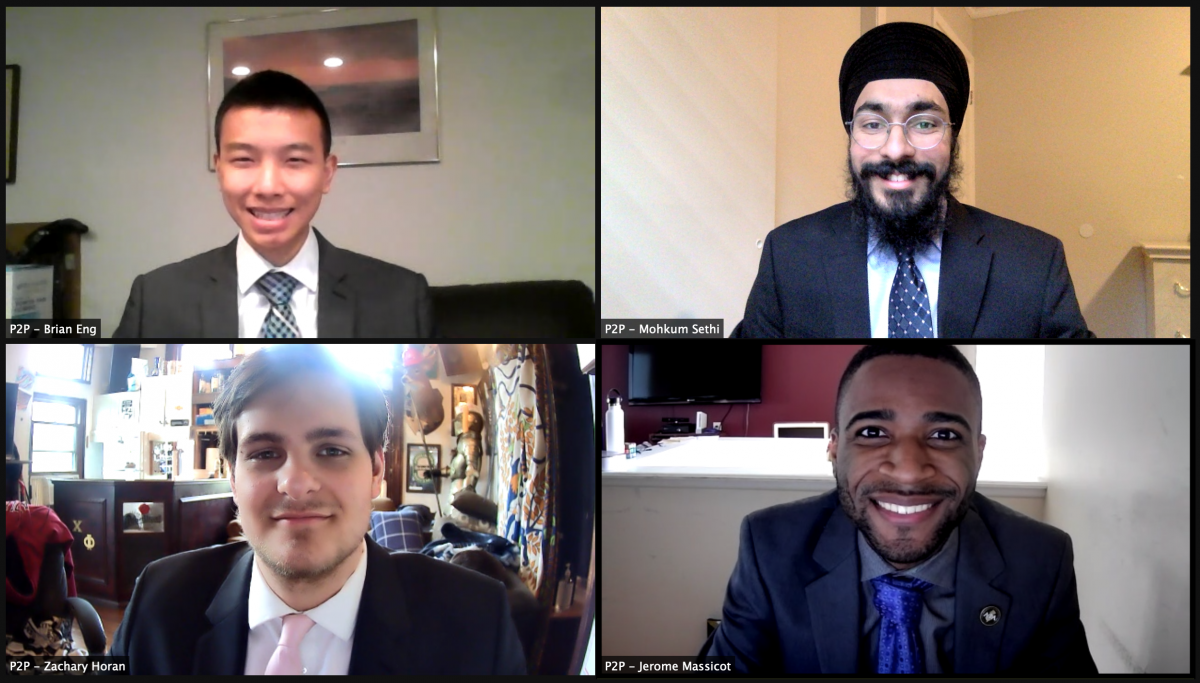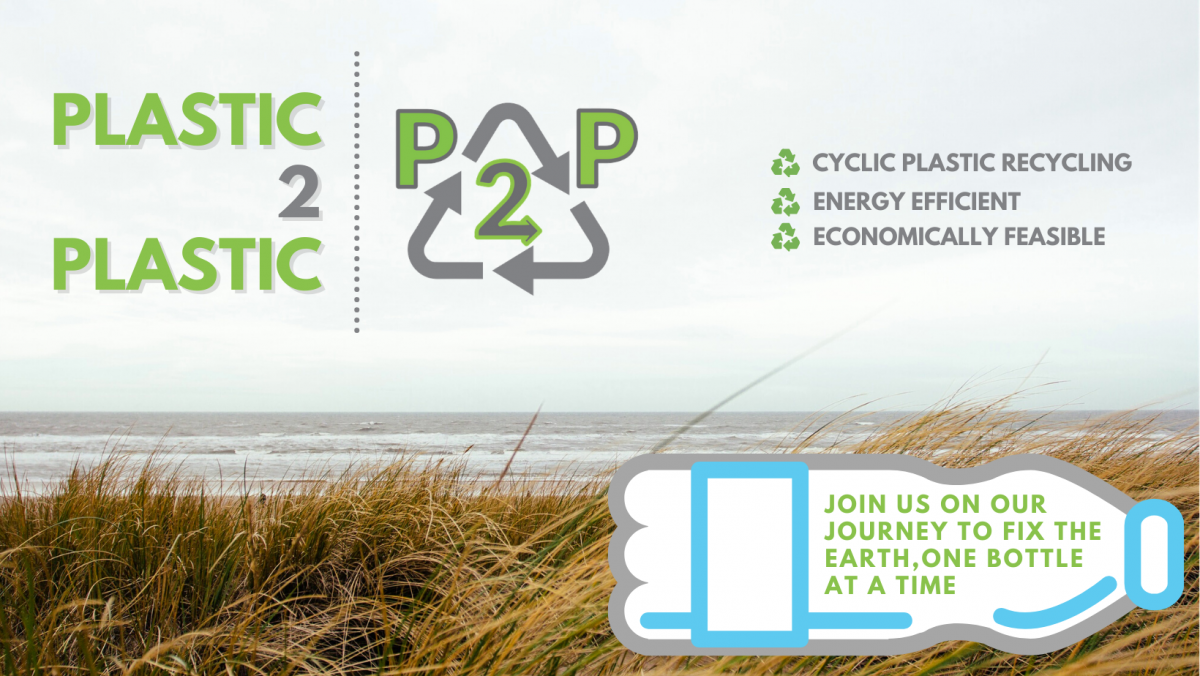Stevens Students Strive to Create ‘a More Sustainable World, One Bottle at a Time’
P2P senior design project presents an innovative approach to recycling PET, the most common type of plastic material
Plastic is everywhere — in our cell phones, our disposable water bottles, our food containers, and just about every one of those packages being delivered to our doorsteps. More than 380 million tons of plastic are produced every year, and as our dependence continues, that number is only going to increase. But once we’re done with it, a staggering 91% of plastic material ends up in our landfills and natural ecosystems such as the ocean, harming animal and plant life, releasing dangerous toxins, and taking up to 200 years to fully decompose. In contrast, roughly 70% of paper is recycled, and 90% of metals are as well.
One of the reasons for that inconsistency is that current commercial plastic recycling processes are typically more expensive and more likely to degrade the quality of the end-product than simply producing new plastics.
Four Stevens Institute of Technology chemical engineering seniors have focused their senior design project on developing a large-scale solution that breaks this cycle with a new cycle: P2P, or plastic to plastic. P2P targets PET (polyethylene terephthalate), a high-performance polymer that’s the most ubiquitous plastic around.
P2P-recycled plastic is as good as new – and better for the earth and the bottom line
Using vapor methanolysis, P2P breaks down plastic into its fundamental building blocks to then create new plastics. It’s an established process that has not been used much in the plastic recycling industry — yet.
“Vapor methanolysis exposes the PET to superheated, highly pressurized methanol to break it down into ethylene glycol (EG) and dimethyl terephthalate (DMT), which are purified and synthesized into new plastics,” explained Mohkum Sethi ’21, who will start working as a process engineer in CAR-T Cell Therapy with Bristol Myers Squibb after graduation. “Roughly 95% of the plastic waste entering the system we designed is recycled as new PET. It’s a viable alternative to existing plastic production and recycling that’s energy efficient, economically feasible, and environmentally friendly. We’re excited about its potential to reduce the burden of increasing plastic use and create a more sustainable world, one bottle at a time.”
Even the so-called waste byproducts of the P2P process are reused within the system.
“What we’re filtering out along the way is the same as what we put into the system initially,” said Brian Eng ’21, who will join Lummus Technology as a process engineer after graduation. “We’re recycling that back into our system at different stages. That means the material can be reused, there’s essentially no waste, and we can reduce the costs of operation.”
The team’s focus was reviewing the existing research and testing the thought process virtually to project how it would perform in the real world.
“We’ve seen instances of vapor methanolysis working with materials on the scale of grams, but our process was modeled to operate on the scale of 2.4 tons per hour,” Eng said. “We were massively scaling up the process and estimating the cost of operation.”
The numbers certainly added up in the right column.
“The economic aspect of plastic recycling is important, so to make sure it worked, we had to take a deep dive into the economics,” said Jerome Massicot ’21, who is preparing to join the BAE Systems rotational program as a process engineer upon graduation. “We saw an opportunity to generate sales of $30 million, and to realize decreases of 37% in annual operating costs and 64% in annual capital costs, compared to the production of new plastics.”
‘I definitely feel we surpassed what we thought we could accomplish’
Although this team first considered other sustainability-based projects such as household energy monitors, P2P turned out to be more fulfilling on a number of levels, particularly during the pandemic.
“Due to COVID and our lack of access to labs, equipment and testing, our plastic recycling idea became the most feasible,” Sethi said. “We were able to use chemical process design software to simulate a large-scale recycling process, without any physical testing. It’s also especially relevant during COVID, when people are more conscious of throwing out potentially contaminated items such as water bottles. But it also felt like we could make a difference. Just looking at the way plastic is synthesized, it's an artificial product, so it only makes sense that you could use chemicals to degrade and recycle it.”
Their advisor, Yujun Zhao, teaching associate professor of chemical engineering and materials science at the Schaefer School of Engineering & Science at Stevens, has recognized both their dedication and their results. “The team was motivated and worked hard and independently from the project identification to the completed proposal,” he said. “The topic they identified is one of current industrial interest to reduce CO2 emissions and further achieve the carbon-neutral goal.”
The professors and others who review the Stevens senior design projects were also impressed, choosing the P2P team among the top 12 finalists in the school’s annual project competition that featured over 140 engineering projects.
“The judges appreciated that we came up with the idea on our own and said our project had a lot of potential,” Jerome said. “We wanted to be unique and take on a project that used chemical engineering in a way that’s relevant and applicable to life. Learning about the plastics industry and about this new method was interesting, especially as it allowed me to take a deep dive into things I’d learned during my co-ops at oil and gas companies. I definitely feel we surpassed what we thought we could accomplish, and it's humbling and exciting to have come this far and to get this recognition. It means a lot to us.”
Learn more about the Department of Chemical Engineering and Materials Science at Stevens:
Chemical Engineering and Materials Science
Chemical Engineering and Materials Science Undergraduate Programs
Chemical Engineering and Materials Science Graduate Programs




